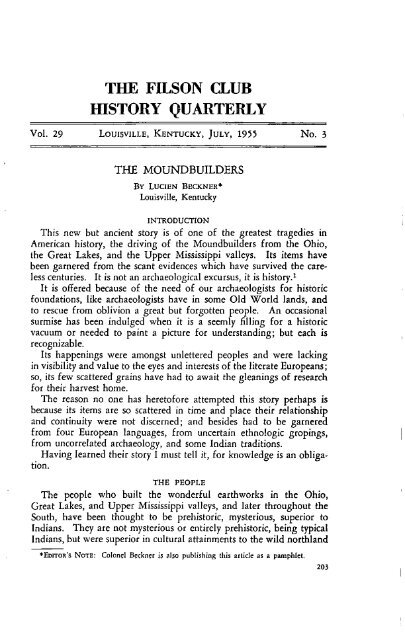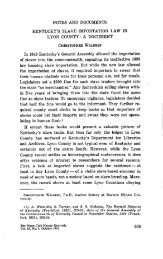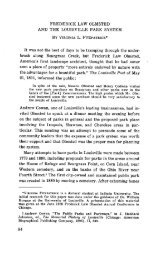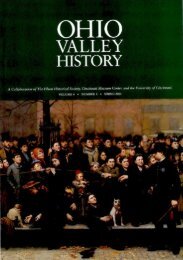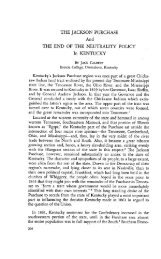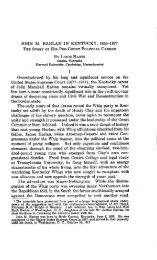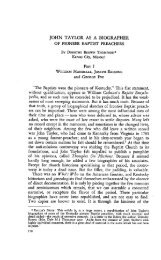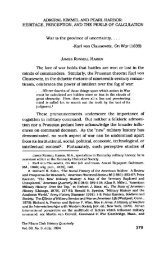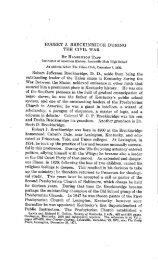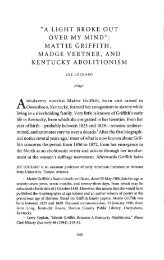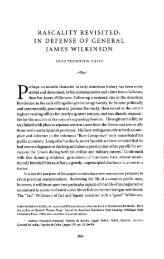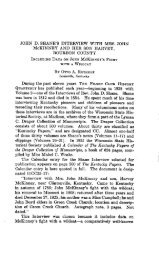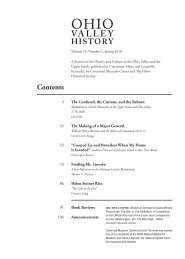the filson club history quarterly - The Filson Historical Society
the filson club history quarterly - The Filson Historical Society
the filson club history quarterly - The Filson Historical Society
Create successful ePaper yourself
Turn your PDF publications into a flip-book with our unique Google optimized e-Paper software.
THE FILSON CLUB<br />
HISTORY QUARTERLY<br />
Vol. 29 LOUISVILLE, KENTUCKY, JULY, 1955 No. 3<br />
THE MOUNDBUILDERS<br />
BY LUCIEN BECKNER<br />
Louisville, Kentucky<br />
INTRODUCTION<br />
This new but ancient story is of one of <strong>the</strong> greatest tragedies in<br />
American <strong>history</strong>, <strong>the</strong> driving of <strong>the</strong> Moundbuilders from <strong>the</strong> Ohio,<br />
<strong>the</strong> Great Lakes, and <strong>the</strong> Upper Mississippi valleys. Its items have<br />
been garnered from <strong>the</strong> scant evidences which have survived <strong>the</strong> careless<br />
centuries. It is not an archaeological excursus, it is <strong>history</strong>/<br />
It is offered because of <strong>the</strong> need of our archaeologists for historic<br />
foundations, like archaeologists have in some Old World lands, and<br />
to rescue from oblivion a great but forgotten people. An occasional<br />
surmise has been indulged when it is a seemly filling for a historic<br />
vacuum or needed to paint a picture for understanding; but each is<br />
recognizable.<br />
Its happenings were amongst unlettered peoples and were lacking<br />
in visibility and value to <strong>the</strong> eyes and interests of <strong>the</strong> literate Europeans;<br />
so, its few scattered grains have had to await <strong>the</strong> gleanings of research<br />
for <strong>the</strong>ir harvest home.<br />
Tile reason no one has heretofore attempted this story perhaps is<br />
because its items are so scattered in time and place <strong>the</strong>ir relationship<br />
and continuity were not discerned; and besides had to be garnered<br />
from four European languages, from uncertain ethnologic gropings,<br />
from uncorrelated archaeology, and some Indian traditions.<br />
Having learned <strong>the</strong>ir story I must tell it, for knowledge is an obligation.<br />
THE PEOPLE<br />
<strong>The</strong> people who built <strong>the</strong> wonderful earthworks in <strong>the</strong> Ohio,<br />
Great Lakes, and Upper Mississippi valleys, and later throughout <strong>the</strong><br />
South, have been thought to be prehistoric, mysterious, superior to<br />
Indians. <strong>The</strong>y are not mysterious or entirely prehistoric, being typical<br />
Indians, but were superior in cultural attainments to <strong>the</strong> wild northland<br />
*EDITOR'S NOTE: Colonel Beckncr i al o publishing this article as a pamphlet.<br />
203
20,1 <strong>The</strong> <strong>Filson</strong> Club History Quarterly [Vol. 29<br />
Algonquians who succeeded <strong>the</strong>m in <strong>the</strong> same regions and whom many<br />
wrongly consider aborigines.<br />
Forty years of research have yielded items which, arranged to<br />
correlate <strong>the</strong>ir chronologic, ethnic, and geographic data, reconstruct <strong>the</strong><br />
epic story of <strong>the</strong> brilliant but unfortunate people who, after <strong>the</strong><br />
Europeans got flashing glimpses of <strong>the</strong>m, vanished as if <strong>the</strong>y had never<br />
been, leaving <strong>the</strong>ir earthworks, mute monuments, to intrigue <strong>the</strong> future<br />
with a puzzle.<br />
<strong>The</strong>ir cultural advancement was not realized until <strong>the</strong> forest-woven<br />
curtain of obscurity was torn aside by <strong>the</strong> axes of <strong>the</strong> settlers; <strong>the</strong>n it<br />
was deemed too late to do more than wonder and surmise. Now at<br />
<strong>the</strong> touch of <strong>the</strong> magic wand of research <strong>the</strong> vanished people come<br />
back and tell <strong>the</strong> grim story of how, despite <strong>the</strong>ir uprooting and dispersion,<br />
<strong>the</strong>y fought for and gained new homes beyond <strong>the</strong> reach of<br />
<strong>the</strong>ir ravening enemies.<br />
<strong>The</strong> Bureau of American Ethnology long ago discovered that <strong>the</strong><br />
earthworks people are <strong>the</strong> ancestors of <strong>the</strong> modern Sioux, Catawbas,<br />
Osages, Omahas, and o<strong>the</strong>rs of <strong>the</strong> same linguistic stock. <strong>The</strong>ir<br />
language, which belongs to <strong>the</strong> Hokan group, along with <strong>the</strong><br />
Coahuiltecan of Mexico and Texas, <strong>the</strong> Yuman of Arizona and Mexico<br />
and o<strong>the</strong>r southwestern tongues, tells from whence <strong>the</strong>y came to <strong>the</strong><br />
rich eastern lands of Chisca and Akan. u<br />
<strong>The</strong> Spanish in Florida called <strong>the</strong>m Chiscas and ]acans (j is <strong>the</strong><br />
Spanish h) ; <strong>the</strong> French in Canada, Akans, Chiscas, or just Sou<strong>the</strong>rners<br />
(Chaouanons); <strong>the</strong> Algonquian Delawares in <strong>the</strong>ir Walam Olum,<br />
Akonapi and Towakan; <strong>the</strong> Iroquois, Ontoaganhas; <strong>the</strong> English in<br />
Virginia, Occaneechees and Rickahockans (Rique Akans) and in <strong>the</strong><br />
Carolinas, IP'occans, Chiskers, Catawbas, and Westos. Western Siouans<br />
yet speak of <strong>the</strong>mselves as wakanda, a which connotes wonderful, sacred,<br />
not gentile. Both Spanish and French speak of <strong>the</strong>ir language as<br />
Chisca. <strong>The</strong> Ohio and <strong>the</strong> Wabash rivers on early French maps are<br />
named Akanseacipi (cipi is Algonquian for river). French maps use<br />
Algonquian names because <strong>the</strong> French settled on <strong>the</strong> St. Lawrence<br />
River amongst Algonquians and learned <strong>the</strong>ir geographic terms.<br />
THEIR COUNTRY<br />
Generally speaking, <strong>the</strong>y filled <strong>the</strong> land between <strong>the</strong> sandstone<br />
mountains of western Pennsylvania, West Virginia, and Eastern Kentucky,<br />
<strong>the</strong> Great Lakes, <strong>the</strong> valley of <strong>the</strong> upper Mississippi, and <strong>the</strong><br />
valley of <strong>the</strong> Cumberland.<br />
Marquette's map of 1673 describing <strong>the</strong> level country of <strong>the</strong> middle<br />
Ol io Valley says: "This river ba<strong>the</strong>s a very beautiful land in which
1955] <strong>The</strong> Moundbuilders 205<br />
are found apples, persimmons, grapes and o<strong>the</strong>r wild fruits. For a<br />
large part it is open but has trees here and <strong>the</strong>re (espace in espace).<br />
<strong>The</strong> Iroquois have destroyed most of <strong>the</strong> inhabitants and are preparing<br />
to destroy <strong>the</strong> rest." This entry is placed on <strong>the</strong> map south of<br />
<strong>the</strong> Ohio about where Lewis and Mason counties, Kentucky, now<br />
are; and where a traveler down <strong>the</strong> great river leaves behind <strong>the</strong> rough<br />
Carboniferous sandstone tors and valleys and passes into <strong>the</strong> level<br />
Silurian and Ordovician limestone lands, called on <strong>the</strong> earliest French<br />
maps Kentayenton-ga, an lroquoian word meaning <strong>the</strong> level country<br />
but which we call <strong>the</strong> Bluegrass. In this rich homeland lived a people<br />
happy and great.<br />
THEIR CULTURE<br />
<strong>The</strong> archaeology of <strong>the</strong> Moundbuilders reveals an aboriginal culture<br />
superior to any north of <strong>the</strong> Pueblos. At Circlevitle, Chillico<strong>the</strong>,<br />
Newark, and dozens of o<strong>the</strong>r places in Ohio, Michigan, Indiana, West<br />
Virginia, and Kentucky; at Cahokia and many o<strong>the</strong>r places in Illinois,<br />
Missouri, Iowa, Wisconsin, and Minnesota are <strong>the</strong> finest earthworks<br />
in <strong>the</strong> United States; <strong>the</strong> most famous being <strong>the</strong> Serpent Mound in<br />
Adams County, Ohio, and <strong>the</strong> great mound at Cahokia, Illinois. <strong>The</strong><br />
highest phase of this culture has been named Hopewell; but radiating<br />
are phases differing about as city and country cultures. <strong>The</strong> phase<br />
found in Kentucky and Indiana has been named Adena. <strong>The</strong>ir differences<br />
are not significant but <strong>the</strong>ir identities are. Because of <strong>the</strong>ir<br />
many mounds, <strong>the</strong>y are spoken of as <strong>the</strong> Moundbuilders. Excavations<br />
have yielded lovely works of art in shell, bone, stone, and copper; and<br />
a few in silver, gold, and even meteoric iron.4 <strong>The</strong>y could gracefully<br />
depict outlines and conceive of complicate conventions but, like <strong>the</strong><br />
Aztecs and Mayas, had not achieved perspective.<br />
Besides <strong>the</strong>se indigenous central cultures, Hopewell-like cultures<br />
were established wherever <strong>the</strong> refugee Akans made settlements. Many<br />
of <strong>the</strong>m, as at Etowah, Georgia; Moundsville, Alabama; Marksville,<br />
Mississippi; Spiro, Oklahoma, are as impressive as <strong>the</strong> original Hopewell.<br />
<strong>The</strong> scattering refugees established <strong>the</strong>ir culture in Virginia,<br />
<strong>the</strong> Carolinas, Tennessee, Georgia, Florida, Alabama, Mississippi,<br />
Arkansas, Oklahoma, Missouri, Iowa, Minnesota, Kansas, Nebraska,<br />
and Dakota.<br />
<strong>The</strong> Moundbuilder culture has many close resemblances to that of<br />
<strong>the</strong> Aztecs and Mayas; too many to be accidental.<br />
SOME CULTURAL TRAITS<br />
<strong>The</strong>y were governed by a number of city states or weak<br />
amphictyonies, more ethnic than civic, which permitted no combina-
206 <strong>The</strong> <strong>Filson</strong> Club History Quarterly [Vol. 29<br />
tion for defense. This, with <strong>the</strong>ir wealth, brought about <strong>the</strong>ir destruction<br />
by <strong>the</strong> predatory Iroquois.<br />
<strong>The</strong>y were farmers, ra<strong>the</strong>r than hunters, raising maize, beans,<br />
pumpkins, gourds, tobacco, and o<strong>the</strong>r crops. <strong>The</strong> artichokes cultivated<br />
by <strong>the</strong>m are now wild along our streams--Indian relics. Nature also<br />
furnished <strong>the</strong>m a wide variety and great abundance of meats and<br />
vegetables. So much easy food allowed time for both study and<br />
improvement which dependence on hunting would not have done.<br />
As maize is a tropical plant, it proclaims <strong>the</strong> origin of its users. <strong>The</strong>y<br />
domesticated <strong>the</strong> dog and perhaps <strong>the</strong> turkey. 5 Living in such<br />
natural and self-wrought abundance, <strong>the</strong>y gave war little heed until<br />
less cultured, but better armed people, assaulted <strong>the</strong>m. <strong>The</strong>n it was<br />
too late.<br />
Beverly, <strong>the</strong> early Virginia historian, says <strong>the</strong> totem of <strong>the</strong> Occaneechees<br />
was a snake. <strong>The</strong> Walam Olum, <strong>the</strong> picture "<strong>history</strong>" of<br />
<strong>the</strong> Delawares, calls <strong>the</strong> Akans "snakes." <strong>The</strong> Serpent Mound is <strong>the</strong><br />
greatest earthwork in <strong>the</strong> world. Many shells have been found bearing<br />
engraved rattlesnakes. Some of <strong>the</strong>ir pictured snakes have plumes<br />
like <strong>the</strong> mythical snake of <strong>the</strong> Mayas. <strong>The</strong> word Sioux means snakes.<br />
<strong>The</strong> Osages were called "snakes." All of <strong>the</strong>se imply serpent worship,<br />
perhaps like <strong>the</strong>ir Pueblo kin today, and based on <strong>the</strong> mystery<br />
of venom.<br />
One of <strong>the</strong>ir shell carvings shows two warriors with lines, running<br />
from <strong>the</strong> breast upward; exactly like <strong>the</strong> cruel sun-dance of <strong>the</strong> western<br />
Sioux seventy-five years ago. Pictures on shells and copper plates,<br />
found from Missouri to Georgia, show many identical details of<br />
symbolic costume, headdress, and instruments; <strong>the</strong> men's faces are<br />
painted, <strong>the</strong>ir noses made up to resemble an eagle's beak, with eagle<br />
wings on <strong>the</strong>ir shoulders and an eagle's tail behind; very like <strong>the</strong><br />
eagle-dance of Pueblo Indians today. Such things indicate religion;<br />
but religion is subjective and cannot be recovered from objective relics.<br />
Small figurines from <strong>the</strong>ir graves show <strong>the</strong>ir summer dress was<br />
breech-clouts for men and skirts for women. In winter <strong>the</strong>y dressed<br />
in skins and furs and cloth with fea<strong>the</strong>rs or rabbit fur skillfully interwoven.<br />
Both sexes wore many ornaments and painted face and body.<br />
<strong>The</strong>ir music was song, time, and din. <strong>The</strong>y had flutes, whistles,<br />
panpipes, shell trumpets, rattles, rasps, jingles, and drums. <strong>The</strong> flute<br />
and panpipes suggest a scale. Stomp was used.<br />
<strong>The</strong>y were traders, importing sea shells and perhaps fea<strong>the</strong>rs from<br />
Florida, gold and perhaps tapa-cloth from Georgia, mica from North<br />
Carolina, copper from upper Michigan, lead from Iowa and Kentucky,<br />
obsidian from Wyoming, grizzly-bear teeth from <strong>the</strong> Rockies, and<br />
pipestone from Minnesota. For <strong>the</strong>se <strong>the</strong>y traded both stone and
1955] <strong>The</strong> Moundbuilders 207<br />
copper ornaments, tools and weapons, and perhaps corn, tobacco,<br />
buffalo skins, furs, and salt. <strong>The</strong>y kept accounts with quipus or knotted<br />
strings as did <strong>the</strong> Incas and <strong>the</strong> Hawaiians.<br />
<strong>The</strong>y venerated <strong>the</strong> calumet, a staff adorned with white fea<strong>the</strong>rs<br />
and skins of snakes; which, borne by a herald, commanded peace.<br />
When a pipe was attached, as an altar on which tobacco <strong>the</strong> sacred<br />
plant was burned, it became <strong>the</strong> peace-pipe. It is <strong>the</strong> caduceus of<br />
Mercury, messenger of <strong>the</strong> gods; and is yet used to command peace<br />
as a scepter by royalty, a mace by deliberative bodies, a badge by<br />
physicians, and a flag of truce. It was introduced into <strong>the</strong> East Indies<br />
by Phoenician traders five thousand years ago and brought to America<br />
ages before Columbus by Polynesian sea-rovers.<br />
<strong>The</strong>y were miners of flint, catlinite, steatite, slate, clay, mica, and<br />
copper; using crude picks made of antler, stone mauls, and fire when<br />
helpful. <strong>The</strong>ir granite and diorite axes were made from small boulders<br />
from <strong>the</strong> glacial drift of nor<strong>the</strong>rn Kentucky northwards.<br />
<strong>The</strong>y had trades and crafts, such as currying, weaving, basketry, pottery,<br />
bone-carving, wood-working, coppersmithing, and many o<strong>the</strong>rs.<br />
<strong>The</strong>y practiced <strong>the</strong> firewalk. John Lederer, traveling amongst <strong>the</strong><br />
refugees in Virginia in 1670, saw an Occaneechee dance in fire for an<br />
hour without hurt. This unexplained miracle came to America as<br />
did <strong>the</strong> calumet and is yet practiced in Pacific lands. Shadrack,<br />
Meshach, and Abednago walked in <strong>the</strong> fire (Daniel 3:26) ; and Isaiah<br />
tells <strong>the</strong> sailors of Dan, who were to go on a voyage in <strong>the</strong> Indian<br />
Ocean, when <strong>the</strong>y walked "through <strong>the</strong> fire, thou shalt not be burned."<br />
(Isaiah 43:2) 7 It is known in ancient English law.<br />
<strong>The</strong>y also shrank heads. Lederer tells that a Woccan chief sent<br />
three young men to a neighboring tribe to kill young girls to accompany<br />
<strong>the</strong> spirit Of his dead son. <strong>The</strong>y returned with <strong>the</strong> skins of <strong>the</strong><br />
heads of three girls. This is <strong>the</strong> first step in making a shrunken head.<br />
<strong>The</strong>y left copper plates and shells on which are engraved a dancing<br />
shaman holding fi shrunken head. You will see shrunken heads also<br />
en <strong>the</strong> Mayan sculptures in Yucatan. <strong>The</strong> art is still practiced in <strong>the</strong><br />
forests of <strong>the</strong> Amazon. 8<br />
<strong>The</strong>y maintained cities of refuge where a fugitive was safe. Per.<br />
haps each tribe, certainly <strong>the</strong> Mascoutins, kept a sacred fire, like <strong>the</strong><br />
ancient Romans. <strong>The</strong> Jesuit Relation of 1647-1648 mentions <strong>the</strong> Fire<br />
Nation, and says <strong>the</strong>y were On.toaganhas.<br />
<strong>The</strong>y used <strong>the</strong> lance, <strong>the</strong> throwing-stick or atlatl, <strong>the</strong> blow-gun, <strong>the</strong><br />
bow and arrow, <strong>the</strong> bolas, <strong>the</strong> macana or flint sword, <strong>the</strong> drill, <strong>the</strong><br />
fish-hook, <strong>the</strong> dibble and hoe, and <strong>the</strong> stone and bone tools and<br />
weapons, which we find everywhere.
208 <strong>The</strong> <strong>Filson</strong> Club History Quarterly [Vol. 29<br />
<strong>The</strong>y often flattened heads by pressure of <strong>the</strong> cradle-board. <strong>The</strong><br />
Spaniards accused <strong>the</strong>m of cannibalism which should not be hastily<br />
denied when it is remembered that <strong>the</strong> cultured Aztecs ate human<br />
flesh. But no one else accuses <strong>the</strong>m.<br />
<strong>The</strong>y had achieved many subjective victories over <strong>the</strong>ir objective resources;<br />
but had reached a time when <strong>the</strong>y needed a messiah to lead <strong>the</strong>m<br />
spiritually out of shamanism and fear of fl e mysteries of <strong>the</strong> world<br />
around <strong>the</strong>m; to teach <strong>the</strong>m <strong>the</strong> superiority of <strong>the</strong> subjective; that<br />
dancing and singing are not purification; that sacrifices do not appease<br />
<strong>the</strong> gods; that tom-toms do not driye out devils; that <strong>the</strong> adoration of<br />
objective things is fruitless. <strong>The</strong>y had evolved as far as <strong>the</strong>y could,<br />
<strong>the</strong>y next needed a mutation; but what <strong>the</strong>y did get will now be told.<br />
CHISCA<br />
One July day in 1540, an Indian chief in nor<strong>the</strong>rn Alabama told<br />
De Soto about a land to <strong>the</strong> north called Chisca, whose people were<br />
rich. De Soto, one of Pizarro's palladins in Peru, eager to find<br />
ano<strong>the</strong>r golden empire, sent two soldiers to spy out that Land of Chisca.<br />
<strong>The</strong>y traveled up <strong>the</strong> Tennessee River in canoes, crossed <strong>the</strong> high<br />
ranges through Cumberland Gap, and marched northward along <strong>the</strong><br />
Traders' or Warriors' Path to Chisca. After twenty-eight days <strong>the</strong>y<br />
returned and reported <strong>the</strong> country between so scant of maize and with<br />
such high and rough mountains it was impassible for <strong>the</strong> army; and<br />
described Chisca as "a poor, little town where <strong>the</strong>re was nothing of<br />
value."<br />
On Wyffliet's map of 1597 Chisca is located south of <strong>the</strong> big<br />
nor<strong>the</strong>rn bend of <strong>the</strong> Ohio, in <strong>the</strong> present Kentucky Bluegrass. On<br />
Franc[uelin's map of 1684 Chisca is more exactly located. A stream<br />
runs into <strong>the</strong> Ohio above <strong>the</strong> Kentucky named "Skippakicipe ou la<br />
Riveire Bleue" (our Licking); to <strong>the</strong> nor<strong>the</strong>ast of it is "Chaskepe,"<br />
which means Chisca-people; and between <strong>the</strong> Licking and a stream<br />
running into <strong>the</strong> Kentucky from <strong>the</strong> north, which <strong>the</strong> map names<br />
"Misseouiecipi" (our Red River), is Chisca.<br />
Today Chisca's visible remains are a mound and a circle on <strong>the</strong><br />
farm of Mr. and Mrs. W. D. Clark, at Indian Fields in Clark County,<br />
Kentucky. A larger circle and o<strong>the</strong>r mounds disappeared a century<br />
or more ago. "This was De Soto's far<strong>the</strong>st point north?<br />
THE WARRIORS' PATH<br />
In 1670 John Lederer, a German traveling in western Virginia and<br />
Carolina, was told by Occaneechee (Akenadzy) Indians about Zynoda,<br />
a great gap in <strong>the</strong> western mountains. <strong>The</strong>y had come through it in
1955] <strong>The</strong> Moundbuilders 209<br />
<strong>the</strong>ir flight from <strong>the</strong> Ohio Valley. This is <strong>the</strong> earliest historic mention<br />
of Cumberland Gap and pethaps <strong>the</strong> third historic mention of a<br />
particular place in Kentucky; Chisca being <strong>the</strong> first; and <strong>The</strong> Fails<br />
of <strong>the</strong> Ohio, reported to La Salle in 1669 by a Seneca chief, <strong>the</strong><br />
second. <strong>The</strong> Warriors' Path running through Cumberland Gap was<br />
mapped by-Franquelin in 1684, which shows it was known early by<br />
<strong>the</strong> French.<br />
This great path is often confused with "buffalo trails." Buffalo<br />
came into <strong>the</strong> Ohio Valley too recently to have worn trails ten to<br />
twenty feet wide and two to four feet deep. <strong>The</strong>y were made by<br />
mastodons and mammoths, whose remains are found at all <strong>the</strong> greater<br />
licks. <strong>The</strong>y and o<strong>the</strong>r salt-seeking animals made paths from salt-lick<br />
to salMick. One of <strong>the</strong>se paths can be seen in Lower Blue Licks State<br />
Park; <strong>the</strong> erosion of huge feet for thousands of years. 1° <strong>The</strong> buffaloes<br />
used <strong>the</strong>m later. 11 <strong>The</strong> Traders' Path followed <strong>the</strong>se when <strong>the</strong> licks<br />
were eu route because game was always found at <strong>the</strong>m.<br />
<strong>The</strong> Traders' Path ran from Lake Erie through central Ohio down<br />
<strong>the</strong> Scioto Valley, crossing <strong>the</strong> Ohio River at several fords above<br />
Maysville, Kentucky; <strong>the</strong>nce south, past <strong>the</strong> upper Blue Licks in<br />
Fleming County, Kentucky, to Chisca, (twelve miles east of Winchester)<br />
which was a mile or more from a lick now called Oil Springs.<br />
Crossing <strong>the</strong> Kentucky River near <strong>the</strong> mouth of Red River, it ran<br />
through Estill and Jackson counties to <strong>the</strong> Flat Lick north of Barbourville<br />
in Knox County; <strong>the</strong>nce to <strong>the</strong> Wasioto Ford of <strong>the</strong> Cumberland<br />
at Pineville, and on through Cumberland Gap. From <strong>the</strong>re one branch<br />
struck into Virginia; ano<strong>the</strong>r to <strong>the</strong> Georgia and Florida coast near<br />
present St. Augustine; and ano<strong>the</strong>r to <strong>the</strong> upper Tennessee River where<br />
<strong>the</strong> travelers took canoes to what is now Georgia and Alabamli.<br />
From Cahokia, Illinois, probably <strong>the</strong> largest center of Akan population,<br />
ano<strong>the</strong>r traders" path crossed sou<strong>the</strong>rn Illinois and Indiana, forded<br />
<strong>the</strong> Ohio River above <strong>The</strong> Falls, ran <strong>the</strong> ridges eastward and <strong>the</strong>n <strong>the</strong><br />
divide between <strong>the</strong> Kentucky and <strong>the</strong> Licking to join <strong>the</strong> Warriors'<br />
Path at Cbisca. This Cahokia Path on Van KeuIen's Map, 1720, is<br />
labeled "<strong>The</strong> route which <strong>the</strong> French take to resort to Carolina. ''lu<br />
<strong>The</strong> Akan name for <strong>the</strong> north-south path was perhaps Scioto, as <strong>the</strong><br />
river it followed in Ohio was so called; <strong>the</strong> Cumberland ford at Pine.<br />
ville, Kentucky, is called Wasioto; and <strong>the</strong> German, Lederer, who<br />
probably recognized <strong>the</strong> Sinuan nasal n, spells <strong>the</strong> gap "Zynoda."<br />
Also <strong>the</strong> Akans who lived along it in Ohio were called Honisioto or<br />
variants of that name. <strong>The</strong> Shawnees later called it Athiomiowe, <strong>the</strong><br />
Path of <strong>the</strong> Armed Ones, as <strong>the</strong>y knew nothing of its commercial<br />
past, only its more recent tragedies.
210 <strong>The</strong> <strong>Filson</strong> Club History Quarterly [Vol. 29<br />
FRANQUELIN'S 1684 MAP<br />
Tl*e map maker thought <strong>the</strong> Upper Tennessee emptied into <strong>the</strong> Ohio through <strong>the</strong><br />
Kentucky. <strong>The</strong> arrow points to Chisca.<br />
I wisll to express my dlanks to Dr. John R. Swanton, Director of <strong>the</strong> United States<br />
Bureau of Ethnology, who from his vast store of knowledge helped me whenever called<br />
upon; also to Samuel G. Stoney of ti*e South Carolina <strong>Historical</strong> <strong>Society</strong>.
1955] <strong>The</strong> Moundbuilders 211<br />
Chisca was in a rich corn-land, but had no o<strong>the</strong>r trading resources.-<br />
It was only a road junction, winning its prosperity by servicing traders.<br />
<strong>The</strong> more detailed and exact information on Franquelin's map implies<br />
unrecorded explorations in <strong>the</strong> Ohio Valley in <strong>the</strong> seventeenth<br />
-century. One relic of this is a stone found in Jackson County, Kentucky,<br />
on <strong>the</strong> Traders' Path on which "June 3, 1632" was carved) 3<br />
None but Spaniards was <strong>the</strong>re so early. In 1630 a group of Spaniards,<br />
having journeyed from Florida, appeared in western New York looking<br />
for a lake containing pure silver which <strong>the</strong>y had heard was near<br />
<strong>the</strong>re. <strong>The</strong>y had traveled <strong>the</strong> Traders' Path through Chisca.<br />
<strong>The</strong> Spanish early founded missions on <strong>the</strong> Georgia-Florida coast<br />
and tried to spread inland. In November, 1566, only sixteen years<br />
after De Soto, Juan Pardo built a fort "northward from St. Elena,"<br />
and left Sergeant Boyano in charge. In January, Boyano reported a<br />
war with a chief named Chisca, and how with his fifteen soldiers<br />
he had killed a thousand Indians! (Spanish self-laudation is not<br />
always restrained by truth.) Later Chisca, with several thousand<br />
Indians (Spanish self-expiation) laid in wait for Pardo, who was<br />
hastening to his sergeant's help, and drove him back to St. Elena.<br />
(Not as doughty as Boyano's immortal fifteen.) Chisca's "several<br />
thousand" was a merchant with his slave porters, assisted by local<br />
Indians. He doubtless resented a Spanish establishment on <strong>the</strong> Traders'<br />
Path where it might try to collect duties from those ancient freetraders<br />
as <strong>the</strong> Spanish did from o<strong>the</strong>r Kentuckians two hundred and<br />
fifty years later at New Orleans.<br />
In 1639 Governor Castro y Pardo of Florida reported to his king<br />
that "hea<strong>the</strong>n Indians who called <strong>the</strong>mselves Ysicas14 are roaming<br />
through this province. <strong>The</strong>y speak <strong>the</strong> Chisca tongue and say <strong>the</strong>y<br />
are from a great river in <strong>the</strong> north." (Ohio) This was ano<strong>the</strong>r<br />
trading party, "roaming" to find customers and slaves.<br />
AN ENGLISH NOTICE<br />
In 1608 Indians told Captain John Smith about Massawamiki, an<br />
Algonquian word meaning Great Southland. <strong>The</strong>y described its people<br />
as so great that modern commentators, not knowing about <strong>the</strong><br />
Akans, have thought <strong>the</strong> Iroquois were meant. But <strong>the</strong> Iroquois did<br />
not become great until twenty or more years later when <strong>the</strong>y got guns<br />
from <strong>the</strong> Dutch; and besides Iroquois were Nor<strong>the</strong>rners to John Smith's<br />
gossips.<br />
VERY POPULOUS<br />
Marquette on his map of 1670 says <strong>the</strong>y were "in such numbers<br />
that <strong>the</strong>y reckon twenty-three villages in one district and fifteen in
212 <strong>The</strong> <strong>Filson</strong> Club History Quarterly [Vol. 29<br />
ano<strong>the</strong>r, lying quite near each o<strong>the</strong>r; <strong>the</strong>y are by no means warlike,<br />
and are <strong>the</strong> people <strong>the</strong> Iroquois come so far to seek in order to wage<br />
an unprovoked war upon <strong>the</strong>m."<br />
Each Jesuit missionary in Canada in <strong>the</strong> seventeenth century made<br />
a Relation (report) regularly to his superior in France. In one of<br />
<strong>the</strong>m we have a glimpse of Akan life. An Indian convert had just<br />
returned from a visit to an Akan town in present Ohio and reports<br />
<strong>the</strong> people so thick that <strong>the</strong> missionary comments, "It must have been<br />
like a market day in France."<br />
On Van Keulen's map of 1720 <strong>the</strong>re is ano<strong>the</strong>r glimpse of Akan<br />
life. About where are <strong>the</strong> sandstone cliffs in Eastern Kentucky, it<br />
notes: "<strong>The</strong> people live in caves [rock shelters] in summer to avoid<br />
<strong>the</strong> great heat of <strong>the</strong> sun." Camping out. 15<br />
<strong>The</strong> life of <strong>the</strong>se people was idyllic: filled with abundance and no<br />
enemies. <strong>The</strong> Jesuit Relation of 1661-1662, by Fa<strong>the</strong>r Lalemant, TM<br />
says <strong>the</strong>ir country "has none of <strong>the</strong> severity of our winter, but enjoys<br />
a climate that is always temperate, . . . <strong>The</strong>ir villages are situated<br />
along a beautiful river which serves to carry people down to <strong>the</strong><br />
Great Lake (for so <strong>the</strong>y call <strong>the</strong> sea) where <strong>the</strong>y trade with<br />
Europeans [Spaniards] who pray as we do."<br />
THE RIQUE AKANS<br />
Upon this ci(,ilization, just evolving into a Copper Age, <strong>the</strong> Iroquois<br />
burst: a pack of ferocious werwolves. In <strong>the</strong> Old World <strong>the</strong> barbarians<br />
overran <strong>the</strong> Roman Empire but were not so devastating.<br />
Iroquoians about 1585 had formed a confederacy of <strong>the</strong>ir Mohawk,<br />
Cayuga, Onondaga, Oneida, and Seneca tribes; <strong>the</strong> best Indian political<br />
organization north of Mexico. <strong>The</strong> Jesuit Relations tell that it made<br />
war on <strong>the</strong> Hurons from 1634 to 1649; on <strong>the</strong> Neutrals in 1651; on<br />
<strong>the</strong> Eries or Cats in 1654; on <strong>the</strong> Andastes and <strong>the</strong> rest of <strong>the</strong><br />
Sou<strong>the</strong>rners (Chaouanons) from 1660 to 1676, when it claimed to<br />
have driven <strong>the</strong>m all out. <strong>The</strong> rich Ohio Valley was a scorched and<br />
bloody desert; its cultured nations far-wandering east, west, and<br />
south)<br />
<strong>The</strong> Senecas were <strong>the</strong> westernmost Iroquoian nation. Westward<br />
from <strong>the</strong>m were <strong>the</strong> Riques (Ericas, Erigas, Eries) or Cat Indians 18<br />
inhabiting <strong>the</strong> south shore of Lake Erie and southward into present<br />
Ohio. <strong>The</strong>ir chief town Rique, in nor<strong>the</strong>astern Ohio, was a city of<br />
refuge.<br />
In 1654 a Huron fled to Rique for refuge whereupon it sent an<br />
embassy to <strong>the</strong> Senecas to beg clemency. But <strong>the</strong> ambassadors were<br />
murdered while in <strong>the</strong> Seneca Council House! This arrogant violence,
1955] <strong>The</strong> Moundbuilde 213<br />
this treachery against ambassadors (sacred in all countries), against a<br />
delegation pleading peace was an act of war and so intended. <strong>The</strong><br />
Iroquois had become so sure of <strong>the</strong>ir superiority because of <strong>the</strong> edged<br />
tools and firearms <strong>the</strong>y had bartered from <strong>the</strong> Dutch, <strong>the</strong>y decided<br />
<strong>the</strong>y would raid and ravage. (Hitler's policies were not new.) <strong>The</strong><br />
Senecas by 1630 had three hundred guns. <strong>The</strong>y invested Rique and<br />
doubtless raided all nearby..<br />
<strong>The</strong> Akans were nowhere prepared for war, having only Stone Age<br />
weapons and could not unite for resistance. Bishop Cammerer, of<br />
<strong>the</strong> Moravian Church, writing in 1750 about this war, says <strong>the</strong> Eries<br />
had only bows and arrows. <strong>The</strong> contemporary Jesuit Relation says<br />
<strong>the</strong>ir ammunition gave out.<br />
Franquelin's map, 1684, locates forty-odd Akan villages destroyed<br />
in this and <strong>the</strong> succeeding wars. <strong>The</strong>ir earthworks yet standing show<br />
<strong>the</strong> accuracy of <strong>the</strong> map. Peace had produced a large and wealthy<br />
population which, depending on its wealth and prestige, had grown<br />
feeble and did not acquire war efficiency until later when as fugitives<br />
<strong>the</strong>y had to fight for new homes.<br />
Indian warfare is a succession of raids made horrible by savage<br />
sadism. <strong>The</strong>re were no war correspondents in those far-away days<br />
but a few incidents did reach some recorders. A Jesuit Relation tells<br />
that at <strong>the</strong> siege of Rique a Seneca chief, a Christian convert, called<br />
to <strong>the</strong> besieged, "You had better surrender; <strong>the</strong> Lord of Life is on<br />
our side," meaning Jesus. <strong>The</strong> besieged chief replied, "We do not<br />
know your Lord of Life; our tomahawks are our lords of life!"<br />
Homer's heroes spoke nothing bolder but helpless Rique fell to <strong>the</strong><br />
overwhelming magic of firearms.<br />
In <strong>the</strong> first fury nei<strong>the</strong>r age nor sex was spared; <strong>the</strong> Jesuit Relation<br />
says blood stood in puddles. Later so many were taken as slaves<br />
that for a generation <strong>the</strong>re were more Akan slaves in <strong>the</strong> Seneca<br />
nation than <strong>the</strong>re were Senecas. What a melting-pot problem!<br />
FLIGHT SOUTH<br />
Some got away and <strong>the</strong> people of <strong>the</strong> nearby towns doubtless fled<br />
with <strong>the</strong>m. <strong>The</strong> rout was panic. Southward <strong>the</strong>y fled along <strong>the</strong><br />
Traders' (from <strong>the</strong>n on <strong>the</strong> Warriors') Path, down <strong>the</strong> Scioto to <strong>the</strong><br />
Ohio, <strong>the</strong>ir enemies hot on <strong>the</strong>ir trail. Every impediment was cast<br />
aside. <strong>The</strong> aged and <strong>the</strong> little children died of fatigue, exposure, and<br />
hunger, but <strong>the</strong>y could not stop to bury <strong>the</strong>m.<br />
<strong>The</strong>y held off <strong>the</strong>ir pursuers occasionally with hurriedly extemporized<br />
fortresses on hilltops. <strong>The</strong> Catawba (Rique) tradition says <strong>the</strong>y built<br />
a fort on <strong>the</strong> headwaters of <strong>the</strong> Kentucky near <strong>the</strong> Warriors' Path.
214 <strong>The</strong> <strong>Filson</strong> Club History Quarterly [Vol. 29<br />
This would make it near <strong>the</strong> present Berea in Madison County, Kentucky,<br />
u° Having lost <strong>the</strong>ir granite axes in fight or flight <strong>the</strong>y made<br />
new ones of sandstone which could not cut wood but could crack<br />
skulls. Fort Ancient in sou<strong>the</strong>rn Ohio dates from this time. <strong>The</strong>re<br />
are many o<strong>the</strong>r forted hilltops in <strong>the</strong> Akan land, makeshift and feeble,<br />
but each declaring defiance and defense; and each helpless against<br />
firearms.<br />
<strong>The</strong> Catawba tradition fur<strong>the</strong>r tells that <strong>the</strong>y left <strong>the</strong> Kentucky fort<br />
and fled along <strong>the</strong> Warriors' Path through Cumberland Gap into Virginia.<br />
<strong>The</strong> Virginia records21 tell how <strong>the</strong> horde irrupted into Virginia<br />
six hundred strong; how in 1656 <strong>the</strong>y whipped a Virginia army<br />
under Colonel Hill; and how Colonel Abram Wood was <strong>the</strong>n sent<br />
against <strong>the</strong>m who induced <strong>the</strong> desperate "Rickahockans" to move south<br />
towards <strong>the</strong> Carolinas.<br />
In this same year one band of <strong>the</strong>m asked admission into <strong>the</strong> Creek<br />
Confederacy and were settled on <strong>the</strong> Tallapoosa River, in Georgia,<br />
calling <strong>the</strong>ir town Tucket Batchet, "<strong>the</strong> town of <strong>the</strong> refugees.''m<br />
Here we must leave <strong>the</strong>m to <strong>the</strong>ir modern historians and watch <strong>the</strong><br />
spreading Iroquois fury.<br />
<strong>The</strong> Iroquois now assailed <strong>the</strong> Akaos next beyond, <strong>the</strong> Honiosants,<br />
Nyhyssans, Monohysanoughs, Onasiotos of <strong>the</strong> Scioto Valley; <strong>the</strong><br />
Mesopeleas (Monsouperias) of sou<strong>the</strong>astern Ohio, West Virginia, and<br />
nor<strong>the</strong>astern Kentucky; <strong>the</strong> Cheskapes and Misseouians of central Kentucky;<br />
<strong>the</strong> Akans of sou<strong>the</strong>rn Indiana and <strong>the</strong> Wabash Valley; and<br />
o<strong>the</strong>rs whose names are not given on <strong>the</strong> maps or elsewhere. Some<br />
fled through Cumberland Gap but most took to <strong>the</strong>ir canoes and fled<br />
down <strong>the</strong> Ohio.<br />
<strong>The</strong>re are but few data about <strong>the</strong>m. <strong>The</strong>re are two forts on<br />
Harrod's Creek in Oldham County, Kentucky, built evidently in a<br />
hurry, which can safely be attributed to <strong>the</strong> fleeing Akans? 3<br />
Some stopped at <strong>The</strong> Falls for awhile, as a Seneca chief tells La Salle<br />
<strong>the</strong>y were <strong>the</strong>re in 1669; and a pile of whitened human bones was<br />
found by <strong>the</strong> Virginia settlers on Sandy Island just below <strong>The</strong> Falls.<br />
Tobacco, a Miami chief, told General George Rogers Clark <strong>the</strong>y were<br />
relics of a battle after which <strong>the</strong> ancient inhabitants fled down <strong>the</strong><br />
river and Kentucky was lost.<br />
Col. James F. Moore, of Kentucky, was told by an old Indian that<br />
<strong>the</strong> early Kentuckians had perished in a war waged against <strong>the</strong>m by<br />
Indians, and that in <strong>the</strong> last great battle <strong>the</strong> defenders were driven<br />
to a small island below <strong>the</strong> Ohio Falls where <strong>the</strong>y were cut to pieces.<br />
Cornstalk told Colonel McKee, commander on <strong>the</strong> Kanawha, that<br />
Ohio and Kentucky had once contained a white people, familiar with<br />
arts of which <strong>the</strong> Indians [Algonquians and Iroquois] knew nothing,
1955] <strong>The</strong> Moundbuilde 215<br />
who had been exterminated by <strong>the</strong> Iroquois; that <strong>the</strong>y, and not <strong>the</strong><br />
Indians, had built <strong>the</strong> old forts long ago.<br />
<strong>The</strong> Osages, who once brought suit against <strong>the</strong> United States to<br />
recover <strong>the</strong>ir Ohio Valley fa<strong>the</strong>rland, left a tradition of <strong>the</strong>ir flight<br />
down <strong>the</strong> Ohio.<br />
Imagination can paint a grim picture of this exodus. <strong>The</strong> Ohio,<br />
Kentucky, and Wabash rivers must have been covered at times and<br />
places with fleets of crowded canoes dug out of huge tulip or chestnut<br />
logs, holding thirty or more each. Whole nations afloat--unknown<br />
terrors ahead, certain death behind--fleeing from a ghastly past into<br />
a menacing future; nothing sure but <strong>the</strong>ir own stout hearts. Almost<br />
<strong>the</strong> only treasures carried from <strong>the</strong>ir despoiled homes were tearful<br />
memories of peace and plenty and happiness. Fear of <strong>the</strong> bloodthirsty<br />
Iroquois and <strong>the</strong>ir magic gunpowder closed ears of husbands<br />
and fa<strong>the</strong>rs against all pleas for rest by <strong>the</strong>ir weary and despairing<br />
families; almost overwhelmed by sickness and fear and saddened often<br />
by death. <strong>The</strong>y camped at night close toge<strong>the</strong>r for comfort and<br />
protection, <strong>the</strong>ir fires blinking dimly through chill river mists. To<br />
<strong>the</strong>se, <strong>the</strong> men who had hunted alongshore by day, brought meager<br />
harvests to <strong>the</strong>ir huddling hordes of misery.<br />
At <strong>the</strong> mouth of <strong>the</strong> Ohio an Osage tradition says half of <strong>the</strong>m<br />
got over <strong>the</strong> Mississippi when a storm wrecked <strong>the</strong> canoes and those<br />
left behind had to wander afoot down <strong>the</strong> eastern bank. This disaster<br />
gave rise to two names: Omaha, up-streamers, who got over; and<br />
Quapaw (Kappa), down-streamers, who did not. From here on <strong>the</strong><br />
distraught refugees can be followed with some detail and accuracy<br />
on <strong>the</strong> French maps. 24<br />
In <strong>the</strong> last quarter of <strong>the</strong> seventeenth century and on into <strong>the</strong><br />
eighteenth <strong>the</strong> French were busy on <strong>the</strong> Ohio and Mississippi laying<br />
<strong>the</strong> foundations of empire. <strong>The</strong> data <strong>the</strong>y ga<strong>the</strong>red were made into<br />
maps. <strong>The</strong>se showed not merely physiographic but ethnographic,<br />
historic and all o<strong>the</strong>r data <strong>the</strong>y deemed pertinent to <strong>the</strong> interests of<br />
Church or State. Ofttimes conditions reported would be so changed<br />
by <strong>the</strong> time <strong>the</strong>y were published <strong>the</strong> same map might show historic<br />
data many years apart.<br />
<strong>The</strong>y show that <strong>the</strong> "Missouris or Osages," and some of <strong>the</strong><br />
"Akanseas or Kansas," got across, Omahas; and that <strong>the</strong> Mesopelias<br />
(Monsoupereas) and some of <strong>the</strong> Akans did not, Kappas (Quapaws).<br />
<strong>The</strong>venot's map of 168l puts Akans and Mesopeleas in West Tennessee;<br />
but this same and later maps show <strong>the</strong>m congested about <strong>the</strong><br />
mouth of <strong>the</strong> Arkansas River. When <strong>the</strong> troubled refugees saw that<br />
mighty river, it must have awakened memories of <strong>the</strong>ir beloved Ohio
216 <strong>The</strong> <strong>Filson</strong> Club History Quarterly [Vol. 29<br />
and Wabash of happier days; and <strong>the</strong>y seized it, drireing off its<br />
aboriginal Caddo inhabitants.<br />
Several Akan splinter tribes, as Ofos and Uspies, settled on <strong>the</strong><br />
eastern bank of <strong>the</strong> lower Mississippi; and <strong>the</strong> Biloxis and Pascagoulas<br />
found pleasant seats on <strong>the</strong> Gulf Coast near <strong>the</strong> present cities which<br />
bear <strong>the</strong>ir names. From <strong>the</strong>re <strong>the</strong>y raided <strong>the</strong> Spanish missions in<br />
Georgia and Florida.<br />
<strong>The</strong> leader of a Spanish retaliatory raid, Captain de Florancia,<br />
reported to Governor Salazar of Florida, "Many years ago <strong>the</strong> Chisca<br />
Indians would come on <strong>the</strong> trails and assault and kill <strong>the</strong> Christians,<br />
or carry <strong>the</strong>m off for slaves. Last year [16761 it became clear <strong>the</strong>y<br />
were Chiscas." Whereupon he led thirty soldiers with firearms and<br />
one hundred and sixty-seven archers against <strong>the</strong>m. (It sounds like<br />
Kentuckians going against <strong>the</strong> Shawnee towns in Ohio.) <strong>The</strong>y<br />
marched from St. Augustine eighteen days westerly and reached <strong>the</strong><br />
Chisca town "on <strong>the</strong> eve of St. Mat<strong>the</strong>w <strong>the</strong> Apostle." This was<br />
near <strong>the</strong> "Choctaws and Pensacolas near <strong>the</strong> sea." <strong>The</strong>y peeped<br />
through <strong>the</strong> palisades of <strong>the</strong> village, which was over three hundred<br />
paces across. "<strong>The</strong> Chiscas were not sleeping but making much noise<br />
around big fires." <strong>The</strong> Spanish set fire to <strong>the</strong> town with <strong>the</strong> loss of<br />
seven killed and forty wounded; <strong>the</strong> Chiscas lost over sixteen dead<br />
and many wounded. On October 5th <strong>the</strong> Spanish army got back to<br />
Apalachi "by <strong>the</strong> favor of God and <strong>the</strong> Virgin of <strong>the</strong> Rosary." Later<br />
<strong>the</strong>se Chiscas helped <strong>the</strong> English drive <strong>the</strong> Spaniards out of Georgia.<br />
<strong>The</strong> Omahas found a home in <strong>the</strong> rich Iowa and Nebraska cornlands,<br />
where <strong>the</strong>ir river and farm culture availed. =a<br />
<strong>The</strong> Osages became <strong>the</strong> dominant banditti of <strong>the</strong> Old Southwest,<br />
compelling <strong>the</strong> stationing of <strong>the</strong> largest part of our army <strong>the</strong>re.<br />
One of <strong>the</strong>ir descendants, Charles Curtis, became Vice-President o/<br />
<strong>the</strong> United States.<br />
Missouri, Iowa, Dakota, Kansas, and Arkansas were named for <strong>the</strong><br />
refugees. Minnesota and Nebraska are Siouan words. One of <strong>the</strong><br />
Siouan tribes of <strong>the</strong> Missouri River, <strong>the</strong> Mandans, kept a knowledge<br />
of <strong>the</strong>ir eastern origin and were called "white people" by o<strong>the</strong>r Indians<br />
because <strong>the</strong>y frequently had gray eyes, chestnut hair, and light skins.<br />
<strong>The</strong>y also made glass beads, a European craft. 26<br />
<strong>The</strong> items on <strong>the</strong> early maps are largely <strong>the</strong> new locations of <strong>the</strong><br />
refugees. <strong>The</strong>re is not space in this paper to give <strong>the</strong>m all but a<br />
few citations will show <strong>the</strong>ir character. <strong>The</strong> Amsterdam map of 1720<br />
has Akans just below <strong>the</strong> mouth of <strong>the</strong> Ohio; <strong>The</strong>venot's (1681) and<br />
De Lisle's (1720) put <strong>the</strong>m opposite <strong>the</strong> mouth of <strong>the</strong> Arkansas in<br />
Mississippi. Van Keulen's of 1720 shows <strong>the</strong> "Kansa or Akansa or<br />
Missouris" on <strong>the</strong> south side of <strong>the</strong> Missouri in Missouri. Pirsson's
1955] <strong>The</strong> Moundbuilders 217<br />
map of 1727 puts Akans and Quappas on <strong>the</strong> Arkansas River. Van<br />
Keulen puts <strong>the</strong> Osages on <strong>the</strong> lower Missouri. <strong>The</strong> Mesopelias<br />
(Monsonperias), whom Franquelin located in nor<strong>the</strong>astern Kentucky,<br />
West Virginia, and sou<strong>the</strong>astern Ohio, are located on Joliet's map<br />
(1674) on <strong>the</strong> eastern bank of <strong>the</strong> lower Mississippi. <strong>The</strong> general<br />
fact <strong>the</strong> maps tell is that <strong>the</strong> people had to scatter, tribes, neighbors<br />
and doubtless families, in hurried and harried flight, never again to<br />
see old neighbors or kin.<br />
Everywhere <strong>the</strong>y carried memories of <strong>the</strong>ir loved ones slaughtered,<br />
<strong>the</strong>ir prolific fields laid waste, <strong>the</strong>ir pleasant homes burned, <strong>the</strong>ir dead<br />
left behind forever; <strong>the</strong> gains of generations of thought, love, and<br />
labor lost. Those who had so suffered carried <strong>the</strong>ir anguish to <strong>the</strong><br />
grave; but <strong>the</strong>ir tales of tragic cruelties goaded <strong>the</strong> descendants of<br />
those peaceful farmers, traders, and craftsmen into becoming <strong>the</strong><br />
fiercest, boldest warriors <strong>the</strong> advancing white man met; warriors who<br />
could not be overcome by pioneer militia, as Kentuckians overcame<br />
<strong>the</strong> Shawnees; but only by professional soldiers with national backing.<br />
Even <strong>the</strong>n <strong>the</strong> professionals had <strong>the</strong>ir set-backs by such Siouan victories<br />
as Custer's Defeat and by such generals as Red Cloud and Sitting Bull.2v<br />
T MA<br />
In his Relation of 1661-1662, Fa<strong>the</strong>r La[emant says, "A band of<br />
Iroquois is going four hundred leagues from here [Montreal] in<br />
pursuit of a natiofi whose only offense consists in its not being Iroquois•<br />
It is called Ontoaganha."<br />
Four hundred leagues (twelve hundred miles) would put <strong>the</strong>m on<br />
<strong>the</strong> Mississippi River where were <strong>the</strong> rich Tamas of Cahokia, wellworth<br />
a robber's raid. <strong>The</strong>y were perhaps <strong>the</strong> last Chisca-speaking<br />
people remaining on <strong>the</strong> original Akan lands.<br />
<strong>The</strong> ruins of <strong>the</strong> great Tama metropolis can now be seen at Cahokia,<br />
opposite St. Louis. Its greatest mound is about one hundred feet high,<br />
one thousand feet long, seven hundred feet wide, and covers sixteen<br />
acres. It has a flat top on which was a cornfield before Illinois bought<br />
it for a State monument. In sight from its summit are fifty or sixty<br />
mounds, many of which would be great elsewhere. Those who built<br />
it must have had a deeply religious fervor to believe in such a<br />
necessity,es It is <strong>the</strong> largest mound in <strong>the</strong> United States. Maybe,<br />
• like <strong>the</strong> Pyramids, it was built with slave labor. <strong>The</strong>y were perhaps<br />
greater traders than <strong>the</strong> Ohio Hopewells but like <strong>the</strong>m were not<br />
warriors. <strong>The</strong>y likely bought <strong>the</strong>ir slaves, although <strong>the</strong> Spanish say<br />
<strong>the</strong> Chiscas captured Christian Indians. <strong>The</strong>ir trade articles were stone<br />
and copper weapons and tools but mostly copper ornaments. <strong>The</strong>y
218 <strong>The</strong> <strong>Filson</strong> Club History Quarterly [Vol, 29<br />
may have been also salt merchants. <strong>The</strong> remains of <strong>the</strong> great Akan<br />
saltworks at Shawneetown, Illinois, are older than its occupation by<br />
Pierre Chartier's renegade Shawoees, about 1760, from which it got<br />
its name, and too extensive to have been <strong>the</strong> work of <strong>the</strong> few months<br />
<strong>the</strong> Shawnees were <strong>the</strong>re.<br />
COMMERCE<br />
Commerce is <strong>the</strong> swapping of things and ideas. Each new idea<br />
increases control of resources and a consequent growth in wealth and<br />
ability. Wealth gives time for thought and ability gives power to<br />
implement it. Commerce compels comparisons and creates desires,<br />
makes routes and roads and develops geography and ma<strong>the</strong>matics.<br />
Without commerce a people accumulates only stagnant centuries; lolls<br />
in unmoving, satisfaction; has only <strong>the</strong> infertile dreams of narrow<br />
horizons. Commerce quickens life, spreads peace and confidence, and<br />
increases populations. It builds and builds. It is <strong>the</strong> vanguard of<br />
civilization.<br />
On Lake Superior <strong>the</strong> Akans got <strong>the</strong>ir supplies of native copper.<br />
Being at <strong>the</strong> head of <strong>the</strong> St. Lawrence River system and close to <strong>the</strong><br />
head of <strong>the</strong> Mississippi River system, <strong>the</strong> copper mines were ideally<br />
placed for canoe transport over an immense area. Verrezano, in 1524,<br />
saw copper ear ornaments on <strong>the</strong> New England coast. Longfellow's<br />
Skeleton In Armor was mailed with Akan copper. In 1535 Cartier<br />
found copper in use on <strong>the</strong> St. Lawrence. In 1539-1540 De Soto<br />
found copper amongst <strong>the</strong> tribes in <strong>the</strong> Sou<strong>the</strong>ast. To all <strong>the</strong>se places<br />
it could have come only from Lake Superior, brought by Akan<br />
merchants. In 1632 Champlain was told by Indians of copper, on Lake<br />
Superior; and in 1636 Segard's History Of Canada says that copper<br />
is found one hundred leagues (three hundred miles by water) from<br />
Lake Huron. This would put it at <strong>the</strong> western end of Lake Superior.<br />
<strong>The</strong> Jesuit Relation of Fa<strong>the</strong>r Dablon (1669-1671) mentions red<br />
copper from <strong>the</strong> Ontonagon River in Upper Michigan. Ontonagon is<br />
a variation of <strong>the</strong> Iroquois word Ontoagana. This name locates an<br />
Akan operation.<br />
<strong>The</strong> Akan miners would take <strong>the</strong>ir copper by canoe to Soult Sainte<br />
Marie and from <strong>the</strong>re some would go up Lake Michigan to what was<br />
<strong>the</strong>n and is yet <strong>the</strong> Chicago River; some would go down Lake Huron<br />
to what is now Sandusky or some o<strong>the</strong>r canoe port on Lake Erie; and<br />
some would go east by <strong>the</strong> Ottawa River or o<strong>the</strong>r water routes. From •<br />
<strong>the</strong> Lake Erie port it was taken to <strong>the</strong> Ohio Hopewell towns where it<br />
was worked up by master craftsmen and sent south by way of tim Scioto<br />
River and <strong>the</strong> Traders' Path. That whicfi left Lake Michigan up <strong>the</strong><br />
Chicago River-"9 was carried to <strong>the</strong> Illinois and "shipped" down it to
1955] <strong>The</strong> Moundbuilders 219<br />
Cahokia where it was made by master craftsmen into trade articles<br />
for <strong>the</strong> traffic south.<br />
On <strong>The</strong>venot's map of 1681 is "Mine of Copper" at Chicago; and<br />
on Joliet's map of 1674 is "Mine of red copper" near Cahokia. We<br />
now know <strong>the</strong>re were no mines of copper at those places; <strong>the</strong> maps<br />
hut show <strong>the</strong> guesses of <strong>the</strong> French about its origin. Those were<br />
points of transport and manufacture. <strong>The</strong>re were no French explorers<br />
in central Ohio early enough to note <strong>the</strong> copper coming by way of<br />
Lake Erie.<br />
<strong>The</strong> mounds along <strong>the</strong> water and land routes have produced quantities<br />
of copper ornaments with some tools and weapons. <strong>The</strong> Tamas<br />
of Cahokia controlled <strong>the</strong> trade routes on <strong>the</strong> Mississippi, Ohio,<br />
Cumberland, and Tennessee rivers and had one by land to Chisca;<br />
and doubtless used <strong>the</strong> Indiana and Kentucky rivers. <strong>The</strong> Hopewells<br />
or eastern Akans controlled <strong>the</strong> upper Ohio and its tributaries and<br />
land routes east and south.<br />
A cache of copper found in Pulaski County, Kentucky. <strong>The</strong>re are five axes, two<br />
spearpoints and two knives; a trader's package.<br />
What <strong>the</strong> Indian traders got for <strong>the</strong>ir copper and o<strong>the</strong>r wares is<br />
aot well known. Sea shells made into art objects and utensils have<br />
been found throughout <strong>the</strong> inland Akan country; and are sometimes<br />
found in caches where <strong>the</strong>ir Indian porters had hid <strong>the</strong>m. Doubtless<br />
many of <strong>the</strong> trade articles from <strong>the</strong> South were perishable, as fea<strong>the</strong>rs,<br />
pearls, and tapa-cloth; but <strong>the</strong>y also brought mica, a little gold, and<br />
perhaps slaves. In sou<strong>the</strong>rn areas, where <strong>the</strong>re is little or no such<br />
stone, large quantities of nor<strong>the</strong>rn stone artifacts are found. Salt and
, i :l ,: ,ll ¸ I .!, i ii II !i I , V ! K :l ! :l i : ]: ::L: j , ;, r,4,,<br />
,.i i li , i ,M ! . : ,I
220 <strong>The</strong> <strong>Filson</strong> Club History Quarterly [Vol. 29<br />
furs, if exported, left no relics. Both salt and stone are heavy and,<br />
if transported long distances by people with nei<strong>the</strong>r beasts of burden<br />
nor wheeled vehicles, must have been by water or slave porters. Copper,<br />
slaves, and pearls are almost <strong>the</strong> only articles noticed in <strong>the</strong> old<br />
chronicles.<br />
No incidents of <strong>the</strong> Iroquois attack on <strong>the</strong> Tamas of Cahokia have<br />
been found, a° Some of <strong>the</strong>m lived at <strong>the</strong> present St. Louis where<br />
<strong>the</strong>y also left great mounds; and some lived in Iowa, where a county<br />
and a town are named for <strong>the</strong>m. Down <strong>the</strong> Mississippi where <strong>the</strong>y<br />
traded <strong>the</strong>y must have had friends, but <strong>the</strong> Ohio Valley Akans had<br />
gotten ahead of <strong>the</strong>m.<br />
Some of <strong>the</strong>m took to <strong>the</strong>ir great trading canoes, dropped down <strong>the</strong><br />
Mississippi and up <strong>the</strong> Ohio and <strong>the</strong> Tennessee. In 1673 Gabriel<br />
Arthur visited <strong>the</strong>m on <strong>the</strong> upper reaches of that river and says <strong>the</strong>y<br />
had "one hundred and fifty great canoes," <strong>the</strong> smallest holding twenty<br />
men. He calls <strong>the</strong>m Tamahittans.zl<br />
Any town on <strong>the</strong> upper Tennessee was too easily found by <strong>the</strong><br />
Iroquois, so <strong>the</strong>y moved to <strong>the</strong> Etowah River in nor<strong>the</strong>rn Georgia,<br />
near Cartersville, where <strong>the</strong>y were protected by <strong>the</strong> valiant Creek<br />
Indians, and built a mound <strong>the</strong>re which is second only in size to <strong>the</strong><br />
one <strong>the</strong>y left at Cahokia.m<br />
About this time <strong>the</strong> Spanish governor in Georgia mentions, as<br />
towards <strong>the</strong> north, <strong>the</strong> countries of Tama, of Catufa (Catawba), and<br />
of Guale.<br />
One of <strong>the</strong> mounds at Etowah has been opened and amongst its<br />
many artifacts are two copper plates with repousse figures of a dancing<br />
shaman, <strong>the</strong> same dancing shaman engraved on shells found in<br />
Missouri, western Kentucky, and Tennessee. <strong>The</strong>ir costumes, ornaments,<br />
and postures are practically identical.<br />
<strong>The</strong>y mark <strong>the</strong> trail of <strong>the</strong> Tamas from Cahokia to Etowah. <strong>The</strong><br />
eagle copper plate found near Cahokia has <strong>the</strong> same convention for<br />
wings and o<strong>the</strong>r features as <strong>the</strong> dancing shaman of Etowah.<br />
<strong>The</strong>y had a war with <strong>the</strong>ir English neighbors in South Carolina<br />
where <strong>the</strong>y were known as Westos because of <strong>the</strong>ir origin. In 1682 a<br />
delegation of <strong>the</strong>m came to La Salle, back in Illinois, to ask French<br />
protection against <strong>the</strong> English in <strong>the</strong> Carolinas who had burned one<br />
of <strong>the</strong>ir towns. La Salle calls <strong>the</strong>m "Chisca." <strong>The</strong> only Indian war<br />
in Carolina at that time was with <strong>the</strong> Westos.<br />
Of <strong>the</strong> movements of <strong>the</strong> Siouan peoples across <strong>the</strong> nor<strong>the</strong>rn Mississippi,<br />
it can only be said that <strong>the</strong>ir descendants were found on <strong>the</strong><br />
plains and in <strong>the</strong> mountains where <strong>the</strong>y had forsaken <strong>the</strong>ir fishing<br />
and farming and adopted a horse and buffalo culture.
1955] <strong>The</strong> Moundbuilders 221<br />
Copper plate from Etowah, Georgia.<br />
Note shrunken head in <strong>the</strong> sharnan's hand.<br />
Shell carving from Lyons County, Kentucky. Shell carving from Central Tennessee.<br />
\
222 <strong>The</strong> <strong>Filson</strong> Club History Quarterly [Vol. 29<br />
CONCLUSION<br />
<strong>The</strong> Joliet map of 1674 says, "All of <strong>the</strong> nations have left <strong>the</strong><br />
country, from terror of <strong>the</strong> Iroquois." In 1681 La Salle wrote Abbe<br />
Bemou that people were even afraid to hunt in <strong>the</strong> devastated<br />
country.<br />
Archaeologists delving in <strong>the</strong> remains of Indian towns have found<br />
thirty or more which show refugee Hopewell cultures in <strong>the</strong> sou<strong>the</strong>rn<br />
and western states; and several have been found in <strong>the</strong> nor<strong>the</strong>ast<br />
which may have been built by captive Akans or by Akan copper<br />
merchants of <strong>the</strong> eastern routes.<br />
Today <strong>the</strong>re are about 45,000 people of refugee Siouan stock in<br />
<strong>the</strong> United States--<strong>the</strong> largest groups being in <strong>the</strong> Dakota and Montana<br />
reservations; <strong>the</strong> Catawbas in <strong>the</strong> South being very few. Besides<br />
<strong>the</strong>se, many have left <strong>the</strong> reservations and become citizens. <strong>The</strong>y all<br />
are becoming farmers or o<strong>the</strong>r businessmen, and <strong>the</strong>ir children are<br />
going to school and college, and doing <strong>the</strong>ir turns in army and navy.<br />
<strong>The</strong> time approaches when <strong>the</strong>y will vanish as separate nations as <strong>the</strong><br />
Oklahoma tribes have done. <strong>The</strong> remaining Iroquois, not counting<br />
peaceful Cherokee, number about 18,000, all in New York, Quebec<br />
and Ontario. <strong>The</strong> scattered Siouans seem to have done better; but<br />
<strong>the</strong>y were more numerous originally.<br />
Kentucky histories tell us that <strong>the</strong> State was not inhabited when <strong>the</strong><br />
white men came, but was only a hunting ground; but Dragging Canoe,<br />
<strong>the</strong> Cherokee chief, told Judge Henderson it was a "dark and bloody<br />
ground," referring to <strong>the</strong> extirpation of <strong>the</strong> natives in <strong>the</strong> brutal<br />
Iroquois wars and <strong>the</strong> <strong>the</strong>n continuing Iroquois raids through Kentucky<br />
to attack <strong>the</strong> Catawbas.<br />
ALGONQUIANS<br />
As <strong>the</strong> Iroquois never colonized <strong>the</strong>ir conquest, it was squatted on<br />
by Algonquian fur hunters--S/iawnees, Delawares, Miamis, Ojibways,<br />
Ottawas, Illinois, and o<strong>the</strong>rs who surged in from north of <strong>the</strong> Great<br />
Lakes and from <strong>the</strong> Atlantic seaboard to ga<strong>the</strong>r furs for British<br />
merchants. But none settled permanently in Kentucky, and none<br />
left <strong>the</strong> aboriginal cultures in <strong>the</strong> Ohio Valley.<br />
After nearly one hundred years (1650 to 1750) of desertion of <strong>the</strong><br />
Ohio Valley by mankind, <strong>the</strong> fur-bearing animals had increased until<br />
<strong>the</strong>y were a bonanza to <strong>the</strong> Indian trappers.8z After <strong>the</strong> French and<br />
Indian War <strong>the</strong> fur merchants of London had <strong>the</strong> king issue an edict<br />
prohibiting white settlement west of <strong>the</strong> mountains, holding that vast<br />
region for <strong>the</strong> Indian trapper. This British policy did much to turn<br />
<strong>the</strong> West against <strong>the</strong>m in <strong>the</strong> Revolution; and it did not help that
1955] <strong>The</strong> Moundbuilders 223<br />
<strong>the</strong>y considered American scalps as fur and paid <strong>the</strong>ir savage employees<br />
for <strong>the</strong>m.<br />
In 1691 New York sent Arnold Viele south to bring "back home"<br />
<strong>the</strong> Algonquians who had fled after <strong>the</strong> Pequot war and King Philip's<br />
defeat. He brought back only <strong>the</strong> Shawnees. <strong>The</strong> first application<br />
of <strong>the</strong> word Shawnee (sou<strong>the</strong>rner) to Indians by <strong>the</strong> English was to<br />
<strong>the</strong>se returning Algonquian Wabans (easterners).<br />
<strong>The</strong>se Algonquian tribes were interlopers without rights in <strong>the</strong> Ohio<br />
Valley, but were sicked onto <strong>the</strong> western settlers, first by <strong>the</strong> French<br />
and <strong>the</strong>n by <strong>the</strong> British, until Indians and whites were enemies at sight<br />
throughout <strong>the</strong> French and Indian War, <strong>the</strong> Revolution, <strong>the</strong> campaigns<br />
of Fallen Timbers and Tippecanoe, and on into <strong>the</strong> War of 1812. Not<br />
until <strong>the</strong>y realized that <strong>the</strong> British could no longer hire <strong>the</strong>m nor protect<br />
<strong>the</strong>m, did <strong>the</strong>y move west.<br />
This paper and my former ones on John Findley and-Eskippakithiki<br />
forna a trilogy of <strong>the</strong> <strong>history</strong> of <strong>the</strong> Old West, never before attempted.<br />
FOOTNOTES<br />
<strong>The</strong> statements herein are a minor part of <strong>the</strong> notes taken ; and every one is authorized<br />
by contemporary map or otficial reports or archaeological discoveries or supported by<br />
ethnologic kinships and topographic features. Limitation of space forbids <strong>the</strong> use of<br />
all <strong>the</strong> data acquired, and for <strong>the</strong> same reason, complete documentation.<br />
Siouan is <strong>the</strong> generic name for all tribes of that stock; as Algonquian is of tribes of<br />
that stock. Akan is often used herein as a synonym of Siouan; but has to be used<br />
specifically also because it is so used on <strong>the</strong> maps. Chisca and Ontoaganha are Siouan<br />
and are nearly always generic. <strong>The</strong> Delawares and Shawnees are Algonquians. Tbe<br />
French called <strong>the</strong> Shawnees Wabans or Easterners because <strong>the</strong>y knew <strong>the</strong>m only in <strong>the</strong>ir<br />
pristine home; <strong>the</strong> English called <strong>the</strong>m Shawnees or Sou<strong>the</strong>rners because <strong>the</strong>y had sojourned<br />
for awhile in tile Gulf States, whi<strong>the</strong>r <strong>the</strong>y had fled from New England (and Virginia?)<br />
wars. <strong>The</strong> English word Shawnee and <strong>the</strong> French Chaouanon, both mean sou<strong>the</strong>rner, and<br />
have been thought to mean <strong>the</strong> same people causing long standing confusions. <strong>The</strong><br />
Chaouanon (sou<strong>the</strong>rner) of <strong>the</strong> Frenchman in Canada was a Siouan of <strong>the</strong> Ohio Val ey;<br />
<strong>the</strong> Shawnee (sou<strong>the</strong>rner) of <strong>the</strong> seaboard Englishman was an Algonquian returning about<br />
1700 from <strong>the</strong> south.<br />
* In modern Siouan tribes, "Wakan" is <strong>the</strong> name of Ogallala, Iowa, and Hunkpapa<br />
bands; and of an Oto gens. Wakanda is used by Omaha, Ponea, Osage, Quapaw, Kansas,<br />
Oto, Missouris, and lowas. Akan in some form is still known to all Siouan stocks.<br />
•In <strong>the</strong> report of <strong>the</strong> Smithsonian Institution for 1916 <strong>the</strong>re is "<strong>The</strong> Art of <strong>The</strong> Great<br />
Earthwork Builders of Ohio" by Charles C. Willoughby. It gives pictures of <strong>the</strong>ir art<br />
in stone, bone, and copper. <strong>The</strong>ir art is also depicted in many governmental and private<br />
publications.<br />
*<strong>The</strong> Indians furnished De Soto two hundred "hens" (turkeys) a day. So many could<br />
have been furnished only from domestic flocks. David lngram who traveled from northwest<br />
Florida to New Brunswick in 1587, saw domestic turkeys.<br />
' <strong>The</strong> Commons House of Assembly of South Carolina early resolved to keep accounts<br />
with <strong>the</strong> Indians with knotted strings (quipu) because <strong>the</strong>y understood <strong>the</strong>m. Its use was<br />
widespread throughout <strong>the</strong> Pacific and both Americas. It was used in Mediterranean<br />
and Indian Ocean lands before <strong>the</strong> days of Solomon. It is mentioned in <strong>the</strong> Koran. It<br />
was a highly developed mnemonic device. We still tie a string around our finger.<br />
v It seems out of place to find a rite of Phoenician fire-worship practiced in <strong>the</strong> wolfhaunted<br />
forests of aboriginal North America. In excavating Indian town sites in <strong>the</strong><br />
Tennessee Valley, Dr. W. S. Webb found several hearths which were probably fire-walk<br />
hearths. (See Bulletin 118, Smithsonian Institution, Bureau of American Ethnology,<br />
1938.) Your author found one at Fullerton, Carter County, Kentucky.
224 <strong>The</strong> <strong>Filson</strong> Club History Quarterly [Vol. 29<br />
* <strong>The</strong>re is a shrunken head at <strong>the</strong> Louisville Free Public Museum which came from<br />
Ecuador.<br />
"Mrs. Clark is a <strong>Filson</strong>ian. This location has not been recognized heretofore by De Soto<br />
students; but <strong>the</strong> nearest contemporary maps permit no doubt. Garcillaso de Ia Vega who<br />
wrote down <strong>the</strong> memories of <strong>the</strong> De Solo survivors after <strong>the</strong>y had become old and forgetful<br />
seems to identify Chisca with Quizquiz, a Caddo town west of <strong>the</strong> Mississippi. His<br />
work is useful, if understood; but as unreliable as <strong>the</strong> memories of <strong>the</strong> ancient men he<br />
interviewed. Chisca was later named Eskippathika by Shawnee settlers.<br />
10 At Big Bone Lick, in Boone County, Kentucky, when discovered in 1729, <strong>the</strong>re were<br />
<strong>the</strong> leg-bones of four mammoths standing, like pillars, <strong>the</strong> o<strong>the</strong>r bones lying where <strong>the</strong>y<br />
fell when <strong>the</strong> ligaments decayed. Bones of extinct animaIs are found in all our licks.<br />
** Buffaloes were very early in <strong>the</strong> West but not in <strong>the</strong> East. No buffalo bones are<br />
found in Indian mounds or graves or rock-shelters. No buffalo-bone artifacts are ever<br />
found in <strong>the</strong> East; or, if so, <strong>the</strong>y are recent. <strong>The</strong> vast Atlantic coast rain-forests stretched<br />
across <strong>the</strong> Mississippi; but <strong>the</strong> white settlers into <strong>the</strong> Ohio Valley found much of it bad<br />
been burned to make grasslands for <strong>the</strong> wild cattle; and <strong>the</strong> natives were yet burning <strong>the</strong><br />
forests off of western Kentucky and parts of <strong>the</strong> adjoining states. This made much of<br />
western Kentucky as treeless as parts of Illinois.<br />
**<strong>The</strong> late Mr. B. T. Bedford, whose farm was where Franklin, Scott, and Woodford<br />
counties corner and about where <strong>the</strong> Cahokia Path might have gone, told me that once<br />
a hole broke into his pasture disclosing an unsuspected spring walled with rock. <strong>The</strong><br />
logs covering it had rotted. Also, in digging holes for fence-posts nearby, a foot or more<br />
down he found one scissors blade and a piece of blue-figured china. Nothing in <strong>history</strong><br />
or tradition accounted for such things <strong>the</strong>re. In an old court paper in Clark County I<br />
remember seeing a statement of an "old Indian trail, <strong>the</strong>n discernible, about two miles<br />
north of Winchester, and directed towards Chisca.<br />
** See Collins' History of Kentucky, Jackson County.<br />
a° Ysica is a Siouan word meaning river-men. Ysa is river and nika, men. <strong>The</strong> Siouan n<br />
is nasal and sometimes hard to distinguish or is even elided in talking.<br />
**Many of <strong>the</strong>se "caves" have been explored by <strong>the</strong> University of Kentucky. <strong>The</strong> best<br />
archaeological work done in Kentucky has been by <strong>the</strong> University of Kentucky. Its department<br />
was founded by Drs. W. D. Funkhauser andW. S. Webb. <strong>The</strong> Kentucky Geological<br />
Survey under Dr. W. R. Jillson did excellent work. But for <strong>the</strong>se <strong>the</strong>re would be little<br />
about Kentucky available to <strong>the</strong> lay- or scientific-reader. Webb and Funkhauser published<br />
jointly Ancient life in Kentucky and an Archaeological Survey of Kentucky. Webb's bibliography<br />
is extensive and of high scientific value. Funkhauser became so thrilled he wrote<br />
a romance about <strong>the</strong> rock-shelter people. Beginning with Ohio, <strong>the</strong> Akan States have<br />
done a great amount of archaeologic exploration; and <strong>the</strong> refugee sites in <strong>the</strong> South and<br />
West have also attracted much scientific work. <strong>The</strong>re is a voluminous Moundbuilder<br />
literature.<br />
aJ Fa<strong>the</strong>r Lalemant was smeared with rosin, encased in bark and burned by <strong>the</strong> Iroquois.<br />
He suffered three days before kindly death ended his agony.<br />
ITHerman, map of 1670, says <strong>the</strong> Akan refugees formerly "came over <strong>the</strong> Alleghenies<br />
and as far as Delaware to trade; but <strong>the</strong> Iroquois Indians went over and destroyed that<br />
very great nation."<br />
,iEries were not Iroquoian, as often asserted. All contemporary and near-contemporary<br />
authorities, without exception, say <strong>the</strong>y are Ontoaganhas, Occaneechees, Akans. Rique,<br />
Erica, Eriga, Erie are forms of <strong>the</strong> Siouan word for raccoon. Arikun is <strong>the</strong> word as<br />
used by <strong>the</strong> Algonquians who adopted it when <strong>the</strong>y migrated from <strong>the</strong> north where <strong>the</strong>re<br />
were no raccoons. <strong>The</strong> early French thought <strong>the</strong> raccoon a kind of cat and <strong>the</strong>refore called<br />
<strong>the</strong> Eries, <strong>the</strong> Cat nation. If to <strong>the</strong> English word cat is added <strong>the</strong> Algonquian awba,<br />
people, we have Catawba. No o<strong>the</strong>r as plausible derivation for Catawba has been found.<br />
))Bancroft who writes of this war against <strong>the</strong> Eries from <strong>the</strong> Iroquoian reports, says<br />
<strong>the</strong>y burned hundreds, even little children with fiendish tortures.<br />
ra<strong>the</strong> head waters of <strong>the</strong> Kentucky River, near tha IVarrio 's Path would have to be<br />
in <strong>the</strong> present Jackson County, Kentucky. <strong>The</strong> Berea fort is <strong>the</strong> onIy one in that region<br />
and is but a little way from <strong>the</strong> path. It has been described by Dr. W. D. Burroughs of<br />
Berea College, in a Kentucky Geological Survey report, series 6, volume 19, pages 138 fie<br />
1926.<br />
= Henning, 402, article iv, of March 10, 1655-1656; also page 422, Dec., 1656.<br />
n This *'town of <strong>the</strong> refugees" on <strong>the</strong> Tallapoosa was very close to Etowah. Its people<br />
are said to have had some sacred copper plates which <strong>the</strong>y displayed in <strong>the</strong>ir religious<br />
feasts and dances. Such plates as were found at Etowah on which were depicted a dancing<br />
shaman in ritualistic attire and accouterments. To unliterate people such plates might<br />
be a holy record, a kind of Bible.
1955] <strong>The</strong> Moundbuilders 225<br />
n An Osage chief in Missouri told Major Sibley, <strong>the</strong> Indiana Agent, that his people<br />
had lived at <strong>The</strong> Falls for some time, and some had had villages nearby. I was told first<br />
of <strong>the</strong>se forts by blr. <strong>The</strong>o. Chamberlain, one of <strong>the</strong> most enthusiastic and learned amateur<br />
archaeologists of <strong>The</strong> Falls region; and was taken to one of <strong>the</strong>m by his son, Mr. Carlyle<br />
D. Chamberlain.<br />
. *'One of <strong>the</strong> great mounds opened at <strong>the</strong> mouth of <strong>the</strong> Ohio (Wickliffe, Kentucky)<br />
has nothing but infant skeletons. Could <strong>the</strong>se be babes stricken by a pestilence like croup<br />
or <strong>the</strong> record of <strong>the</strong> murder of little ones <strong>the</strong>y could not carry with <strong>the</strong>m?<br />
" A distinguished Omaha Indian, Dr. Francis La Flesche, an accomplished ethnologist<br />
of <strong>the</strong> Smithsonian Institution, graciously gave me helpful interviews on two occasions.<br />
** <strong>The</strong> myster/ of <strong>the</strong> bfandans has intrigued all who knew <strong>the</strong>m. <strong>The</strong>y called <strong>the</strong>mselves<br />
People of <strong>the</strong> Ruffed Grouse a bird of <strong>the</strong> eastern forest lands not of <strong>the</strong> western<br />
pla as. <strong>The</strong>ir blond features, traditions, and making glass beads suggest European blood<br />
and craft. In <strong>the</strong> early Seventeenth century <strong>the</strong>re were sent to Virginia some Germans and<br />
Italians. <strong>The</strong>y disappeared, some notices saying <strong>the</strong>y decamped to <strong>the</strong> Indians. In Virginia<br />
no Italian and few, if any, German names survive which can be attributed to those<br />
people. Taliaferro is a large Virginia family with an Italian name, but <strong>the</strong> first one came<br />
in with Sir Thomas Lunsford after <strong>the</strong> battle of Nasbey, one of his "beef-eaters" at <strong>the</strong><br />
Tower of London fleeing Parliamentary wrath. <strong>The</strong> Minors, ano<strong>the</strong>r large Virginia family,<br />
descend from a man named Mindert, whose antecedents are not known but are thought<br />
to belong in Holland ra<strong>the</strong>r than Germany. <strong>The</strong> Maodans have aIso been "identified"<br />
with <strong>the</strong> Welsh who came with Prince Madog.<br />
*7 1 met Sitting Bull once, with thirty or forty of <strong>the</strong> leading men of his nation, en route<br />
to Washington to see <strong>the</strong> President. Words cannot describe <strong>the</strong> impression made by <strong>the</strong><br />
magnificent dignity of those men. Great heads, noble countenances, and splendid figures<br />
were characteristics of every one. <strong>The</strong>y were impressive relics of Akan civilization,<br />
descendants of <strong>the</strong> Moundbuilders. I bought Sitting Bull's pipe, catlinite with totems<br />
carved on its long ash stem.<br />
** <strong>The</strong> Siouan peoples believed <strong>the</strong>ir deities resided in high places. This may be <strong>the</strong><br />
motive of <strong>the</strong> mounds. To <strong>the</strong> Dakotas, when <strong>the</strong>y went west, <strong>the</strong> Black Hills were<br />
<strong>the</strong> home of <strong>the</strong>ir gods and <strong>the</strong>y resented <strong>the</strong>ir sacrilegious invasion by <strong>the</strong> gold hunters.<br />
<strong>The</strong> Aztecs, Toltees, and Mayas built pyramids for <strong>the</strong> same reason. <strong>The</strong> aigurats of <strong>the</strong><br />
Sumerians, <strong>the</strong> Tower of Babel, and <strong>the</strong> Greek Olympus were <strong>the</strong> same idea; and perhaps<br />
our monuments and mounded graves are its attenuated relics.<br />
Chicago is a Siouan word meaning "<strong>the</strong> main stream." <strong>The</strong> little Chicago River was<br />
not a "main" stream but it was <strong>the</strong> stream which ancient travelers took to go from Lake<br />
Michigan to <strong>the</strong> main stream, <strong>the</strong> Mississippi, as <strong>the</strong> Algonquians called it.<br />
to Bancroft says La Salle saw at Cahokia, twenty years after, "<strong>the</strong> slain were left to be<br />
rent in pieces by <strong>the</strong> wolves. Not only had <strong>the</strong> recent dead [AIgonquian] but in nnheard<br />
of sacrilegious wrath <strong>the</strong> Iroquois had burst open <strong>the</strong> pits of past generations [Tamas]<br />
and scattered <strong>the</strong>ir bones over <strong>the</strong> plain."<br />
Arthur went with <strong>the</strong>m to raid <strong>the</strong> English in Carolina and <strong>the</strong> Spanish in Florida;<br />
and later against an Akan town in northwestern Kentucky on "a very great river," (Ohio).<br />
He was wounded and captured but treated kindly. He says, "This is a great towne and<br />
a great number of Indians. [<strong>The</strong> Ashland (Ky.) works.] This river runs northwest<br />
about a day's journey lower [down] where <strong>the</strong> inhabitants are an innumerable company<br />
of Indians." [<strong>The</strong> Scioto Valley and Mason and Carter counties, Kentucky, works.]<br />
Arthur's story has been published by Swanton in his ",<strong>The</strong> History of <strong>the</strong> Creeks" and<br />
byt illson in "<strong>The</strong> Kentucky <strong>Historical</strong> <strong>Society</strong> Register.'<br />
<strong>The</strong> great mound on <strong>the</strong> north bank of <strong>the</strong> Etowah River near Cartersville, Georgia,<br />
although truncated, is 61 feet high. <strong>The</strong> diameters of <strong>the</strong> base are 380 by 330 feet; <strong>the</strong><br />
diameters of <strong>the</strong> top are 170 by 176 feet. It has a road running up one side to within<br />
18 feet of <strong>the</strong> top. Its shape is very nearly a duplicate of <strong>the</strong> Cahokia mound. Your<br />
author has visited both Cahokia and Etowah.<br />
u Joliet's map I674. By this date he reports great increase in "castor" (beaver).


